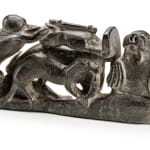-
Artworks
JOE TALIRUNILI (1893-1976) PUVIRNITUQ (POVUNGNITUK)
Hunter and Walrus Scene, c. 1962-65stone, 4.75 x 14.75 x 2.25 in (12.1 x 37.5 x 5.7 cm)
signed and inscribed with artists's disc number, "JOE E-9 818".LOT 87
ESTIMATE: $15,000 — $25,000
PRICE REALIZED: $17,080.00Further images
-
(View a larger image of thumbnail 1
)

-
(View a larger image of thumbnail 2
)

-
(View a larger image of thumbnail 3
)

-
(View a larger image of thumbnail 4
)

-
(View a larger image of thumbnail 5
)

-
(View a larger image of thumbnail 6
)

-
(View a larger image of thumbnail 7
)

-
(View a larger image of thumbnail 8
)

-
(View a larger image of thumbnail 9
)

Most famous for his Migration Boats (and other marine adventures) which he carved throughout the latter half of his career, Joe Talirunili is remembered also for his often-quirky carvings and...Most famous for his Migration Boats (and other marine adventures) which he carved throughout the latter half of his career, Joe Talirunili is remembered also for his often-quirky carvings and sculptures of other themes and subjects, as well as an interesting body of drawings and prints (for which, it should be noted, he carved his own stone blocks). Most of his carvings are portrayals of single, standing figures: hunters with their weapons, women holding utensils, owls, and occasionally other animals such as caribou (see Lot 142). Exceedingly rare, but among his most remarkable sculptures, are hunting scenes. Two walrus hunting scenes were owned by Bill Johnstone, a collector in the U.K. [1] This Hunter and Walrus Scene is the larger of the two and the most impressive example we have seen.
In fact, apart from his boats, this work is the largest Talirunili sculpture we know of. Hunter and Walrus Scene is a work from the early 1960s, created when Joe was actively carving print stones for the new graphics program in his community. [2] We believe this is significant: it means that the artist was beginning to think in terms of narrative and story lines in his artmaking. This sculpture truly is a “scene” (arguably it’s more than one scene, just like many of his print images). Set along an expansive groundline, it incorporates not only the hunter and his present quarry, but also animals not related to the current action (in fact, the bear and otter are preying upon the other animals). The orientation along a groundline also reminds us of Joe’s stonecut prints of the period. In Puvirnituq, the uncarved outer edges of stone blocks were inked, thus “framing” the images and accidentally creating “groundlines” at most bottom edges. We are reminded especially of Joe’s print A Sure Good Meal, which depicts a caribou hunter and assorted animals (including an otter and fish!). [3]Quite apart from its impressive scale and interesting imagery, Hunter and Walrus Scene is cleanly carved in a higher-quality stone than we see in many of Talirunili’s works, and is finished to a surprising degree. Joe makes good use of negative space, which gives the sculpture added vitality and visual interest. And in typically quirky Joe fashion, he simply conjures up a rifle support and a hunting blind to assist with the narrative. The hunter’s pose is dynamic and realistic, in obvious – and hilarious – contrast with the laid-back and truly charming figure of the basking walrus. Either the walrus is completely oblivious to his possible fate, or he is confident that Joe will miss his mark! Absolutely brilliant.
1. Both examples are illustrated in Ken Mantel et al., Tuvaq: Inuit Art and the Modern World (2010), p. 210. A later and rather cruder seal hunting scene is illustrated in Marybelle Myers, Joe Talirunili: a grace beyond the reach of art (Montreal: FCNQ, 1977), p. 24.
2. The sculpture has been assigned a date of c. 1962 but might have been carved a couple of years later.
3. The print is #336 in the 1966 Puvirnituq catalogue; interestingly, Joe’s carved stone block for this print is illustrated in Marybelle Myers, op. cit., p. 63.
References: The best introduction to the life and work of Joe Talirunili is still the landmark monograph by Marybelle Myers, Joe Talirunili: A Grace Beyond the Reach of Art, (Montreal: La Federation des cooperatives du Nouveau-Quebec, 1977). For Migration Boats by the artist see First Arts, 4 December 2023, Lot 37; First Arts, 1 December 2020, Lot 32; and First Arts, 28 May 2019, Lot 18 (and also two superb standing figures by the artist, Lots 55, 56). For a lovely Horned Owl see First Arts, 14 June 2022, Lot 90.Provenance
Waddington’s Auctions, Nov. 1997, Lot 1233; Alaska Shop, New York;
Acquired from the above by Bill Johnstone Collection, U.K., 1997;
His Sale, Waddington's, 20 November 2018, Lot 38 (as “Hunter Harpooning Walrus”);
Acquired from the above by the present Private Collection, Europe.Exhibitions
Canada House, London, U.K., 2010.Publications
Published: Ken Mantel et al., Tuvaq: Inuit Art and the Modern World, (Bristol, UK: Sansom and Company Ltd., 2010), fig. 222, p. 210.
-
(View a larger image of thumbnail 1
)
Join our mailing list
* denotes required fields
We will process the personal data you have supplied in accordance with our privacy policy (available on request). You can unsubscribe or change your preferences at any time by clicking the link in our emails.









